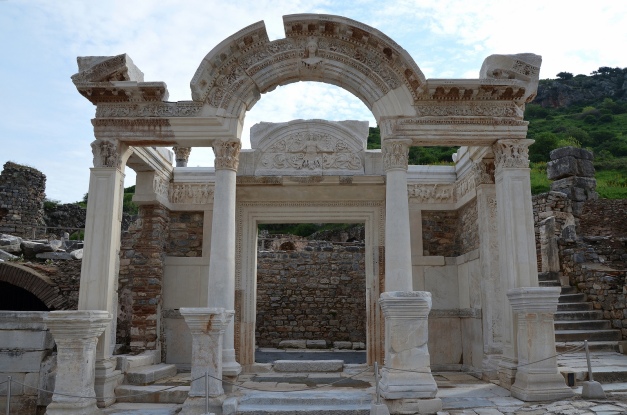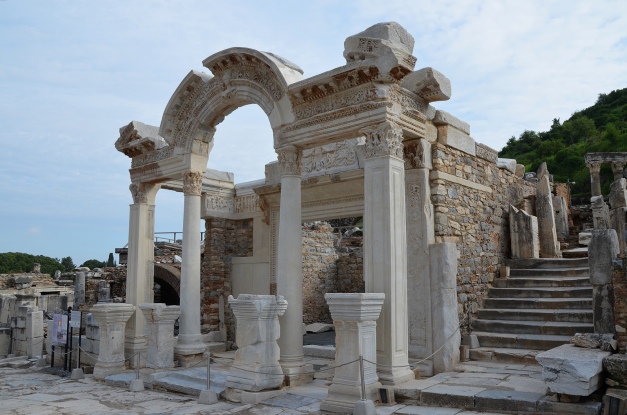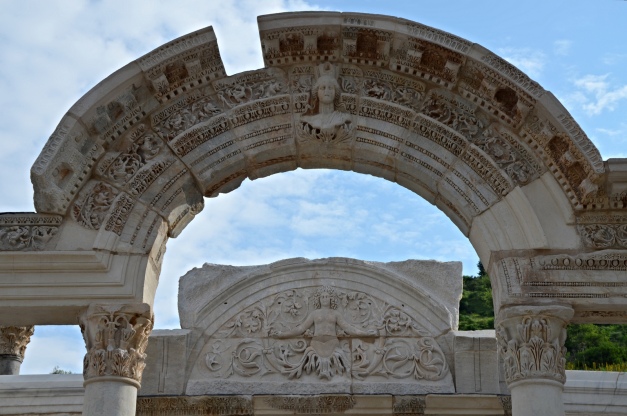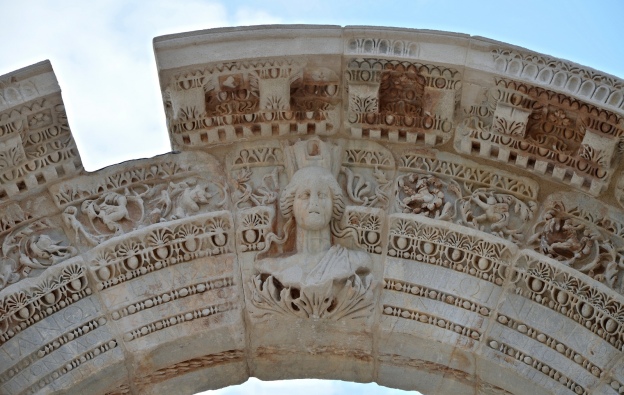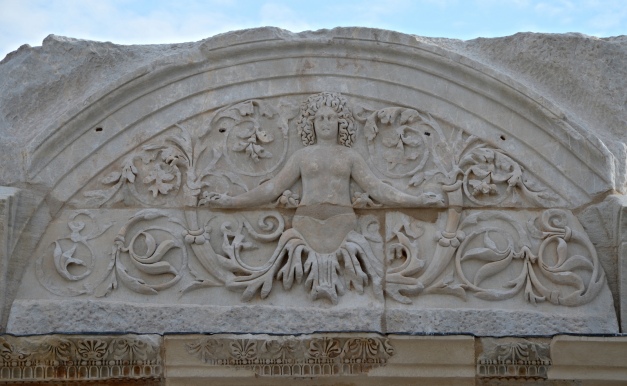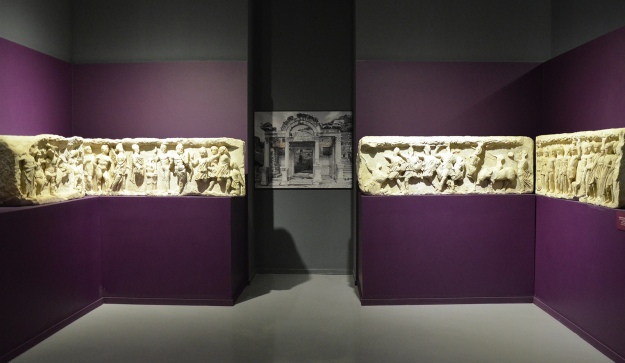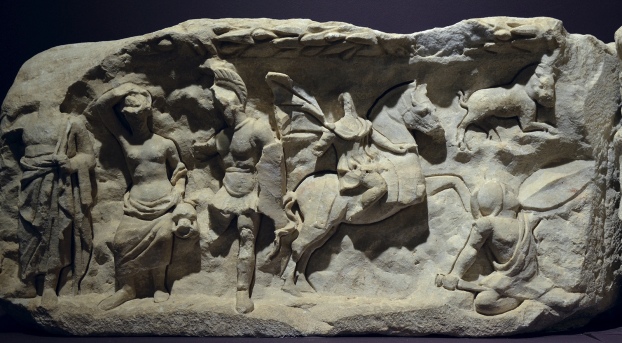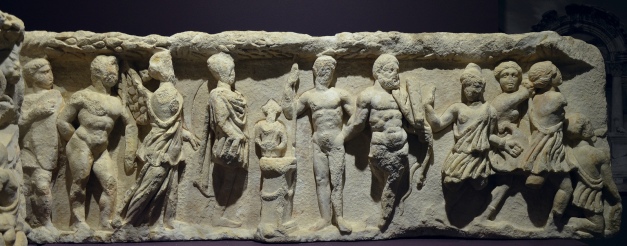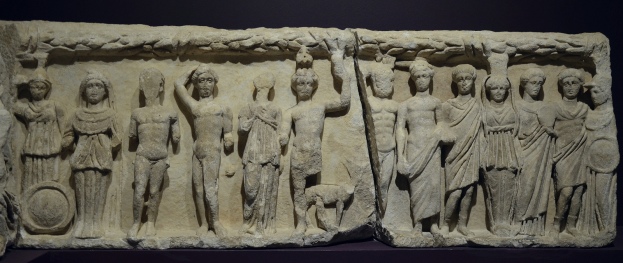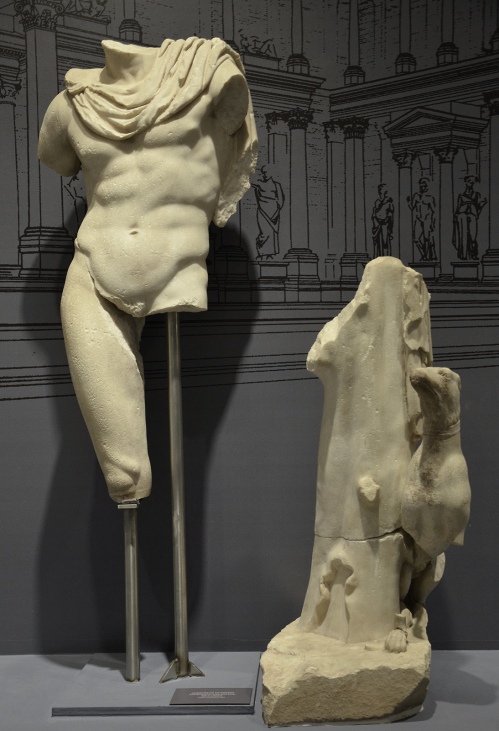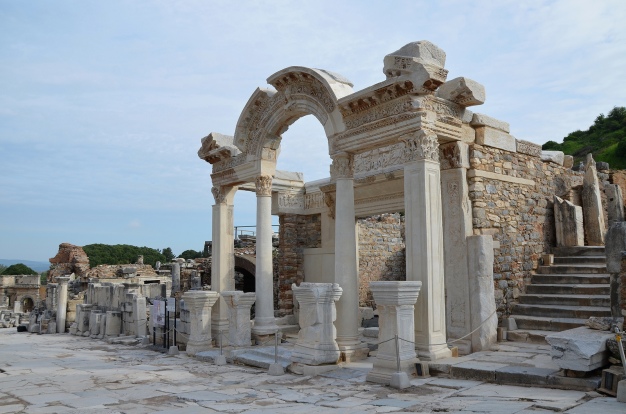The Temple of Hadrian at Ephesus is regarded one of the most famous monuments of the ancient city of Ephesus. It lies on the south side of Curates Street, one of Ephesus’ main arteries connecting the Gate of Hercules with the Library of Celsus.
The remains of the Temple were unearthed in 1956 during excavations carried out by the Austrian Archaeological Institute (ÖAI). Due to its excellent state of preservation and cultural and historical importance it was rebuilt with original building elements in 1957/1958. There were also some supplementation with modern building material so as to reproduce the building’s precise appearance more fully. In 2012 the Austrian Archaeological Institute began an extensive conservation project with the support of the J. M. Kaplan Fund. The project was completed in September 2014. All the photos included in this post were taken in April 2015 after the conservation was finished.
According to an inscription engraved on the archivolt of the entablature, the small temple-like structure was dedicated to Artemis Ephesia, Emperor Hadrian and to the demos of Ephesus, by the asiarch Poplius Vedius Antoninus Sabinus of Ephesus.
The building is a tetrastyle (4 columns) prostyle (only columns are along the front side) temple of modest dimensions and has rich architectural and sculptural decorations. Two Corinthian columns and two pillars on the edges support the entablature with a curved Syrian type pediment decorated with floral patterns and bearing a relief of Tyche, the goddess of victory. The Goddess is wearing a crown depicting the walls and towers of the city.
Behind the arch is the pronaos, the inner area of the temple’s portico. It has a door opening crowned by a typanum, a semi-circular relief depicting a female figure (probably Medusa) among acanthus leaves and scrolls.
The door leads to the cella, the interior of the monument. The cella measured 7.50m in width and 5m in length and was roofed by a barrel vault.
The pronaos is decorated with a frieze consisting of four marble slabs depicting the foundation of the city of Ephesus by the Athenian prince Androclus. The frieze is not Hadrianic as it was not sculptured at the same time as the Temple. It was probably added to the monument from an unknown building during a restoration in the 4th century AD. The frieze on the Temple is a copy, the original is on display in the Ephesus Museum.
The first slab depicts five figures: from left to right; a male possibly representing Zeus, a Nymph representing the Hypelaios spring, a warrior and Androclus on horseback attacking a wild boar. Beneath the figure of the animal is a fallen warrior. The foundation myth of Ephesus states that Androclus, the son of Athenian king Codrus, consulted the oracle of Apollo in Delphi, who prophesied that fish and a wild boar would lead him to the site where he would found a new city. After landing on the coast of Ionia near the later harbour of Ephesus, the Greek colonists – in search for a new location for his people to protect them from the Dorian invasion – cooked some fish. One of them leaped out of the brazier scattering coals and set fire to the nearby bushes, from which a boar ran out. Androclus slew the boar and established the city where the animal fell.
The second frieze shows a Roman Emperor making a sacrifice in front of an altar decorated with garlands. The Emperor wears a military tunic and paludamentum (a military robe), and is crowned by a Nike. On the right of the altar is a male figure, possibly Theseus, and next to him Heracles while four Amazons are fleeing from him. The Amazons, according to myth, took refuge in the Temple of Artemis at Ephesus from both Heracles and Dionysus.
The third frieze depicts three female figures which have been identified as Amazons fleeing from Dionysus. Dionysus is represented embracing a Satyr in the centre of the relief with Pan holding a thyrsus on his right. Next to him a figure sits on an elephant and a dancing Maenad is holding a cymbal.
The fourth frieze portrays various divinities: from left to right; Dea Roma, Selene (Moon), Helios (Sun), Apollo, Artemis, Heracles, Dionysus, Hermes, Aphrodite, Ares and Athena. In the middle of the frieze is Androclus and his dog.
During the imperial period, the image of the city founder could be seen throughout the city. Androclus was also represented in various statuary forms while the boar appeared on coins minted in Ephesus. A statue from the Fountain of Trajan shows him standing with his dog.
Another statue was discovered in 1927 in the Vedius Baths and Gymnasium complex at Ephesus by the Austrian team who was excavating the site. The statue was dated to ca. 150 AD. It is thought to represent Antinous as Androclus. A fragment of a dog’s paw grasping a stiff hair from a boar was found next to the statue. This indicates that Androclus was shown boar hunting.

Antinous portrayed as the hero Androclus, mythical founder and first king of Ephesus, ca. 150 AD, from the Vedius Baths and Gymnasium complex at Ephesus Izmir Archaeological Museum, Turkey
Long before the frieze was added in the 4th century AD, the Temple had suffered extensive damage following the 262 AD earthquake. It was renovated with several additions and alterations about forty years later, when the pedestals with the statues of the Tetrarchs were added to the facade. The pedestals with inscriptions in front of the temple are the bases for the statues of the emperors Diocletian, Maximian, Constantius I, and Galerius. The originals of the statues have not been found.
The original function of the temple-like structure remains unknown but it was long assumed to have been an official cult temple of the emperor Hadrian because Ephesus received permission to construct such a building. However this interpretation has since been refuted since it hardly seems possible that the Ephesians would have honored Hadrian with such a small temple. After Hadrian’s second or third visit to Ephesus in 129-131 AD, the Emperor granted the city a second “neokorate” (temple warden of the imperial cult – the first neokorate was granted during the reign of Domitian). Between 1984-86, archaeologists uncovered a massive structure in the northwest part of the city which has been attributed to the Olympieion, a temple dedicated to Hadrian Olympios. The Olympieion would therefore be connected to the second neokorate temple but this has also been debated amongst scholars.

Ephesos (AD 117-138) AE 32 – Hadrian Laureate and draped bust right / Two temples, each containing standing male figure holding scepter, viewed in perspective, vis-à-vis; Π and Δ in pediments.
Hadrian visited Ephesus on at least two occasions during his journeys through the eastern part of the Empire; in August 124 and five years later in 129 (and possibly in 131). The outcome of his visits was several monuments and benefactions. In return the Emperor was granted the honorific title of “founder and savior” by the council (boule) and the Ephesian people (demos).
Sources:
* TEMPLE OF HADRIAN – Conservation Project 2012 – 2014 (pdf)
* Dalaveras Andreas , Dawson Maria-Dimitra , “Ephesus (Antiquity),
Temple of Hadrian“, Encyclopaedia of the Hellenic World, Asia Minor (2005)
* Aristodimou Georgia, “Ephesus (Antiquity), Olympieion”, Encyclopaedia of the Hellenic World, Asia Minor (2005)
* Erich S. Gruen (ed.), Cultural Identity in the Ancient Mediterranean. Issues & Debates. Los Angeles: Getty Research Institute, 2010.
* Bowie, E. 1971. ‘The “Temple of Hadrian” at Ephesus‘
* “Temples of Hadrian, not Zeus” by Barbara Burrell, Dept. of Classics
Univ. of Cincinnati, February, 2003
Originally published on Following Hadrian, republished with permission.
